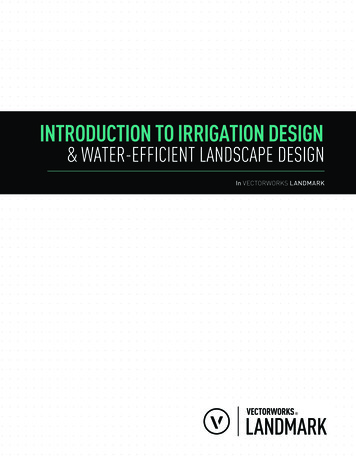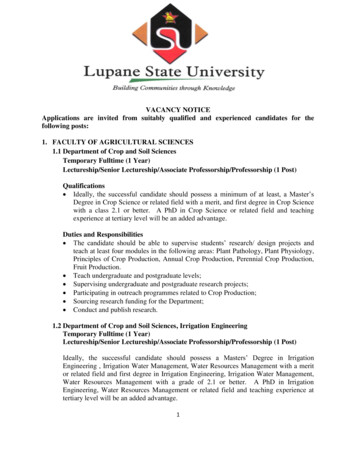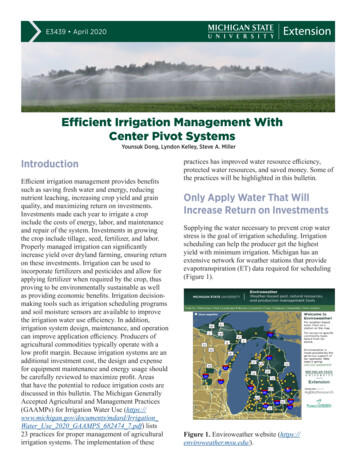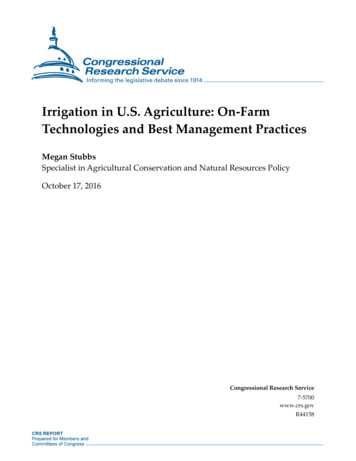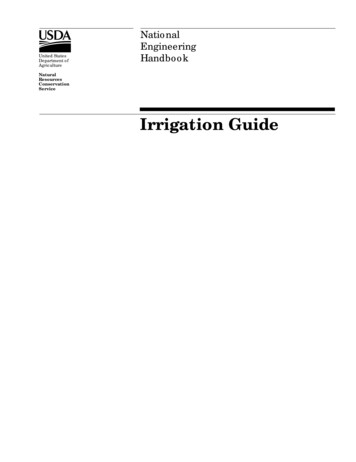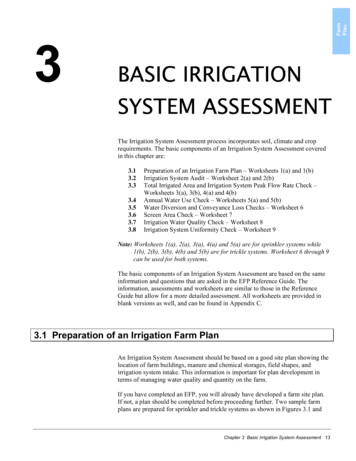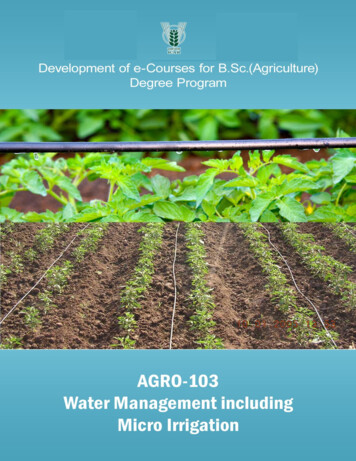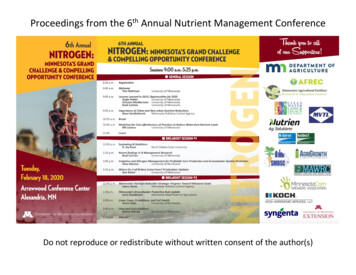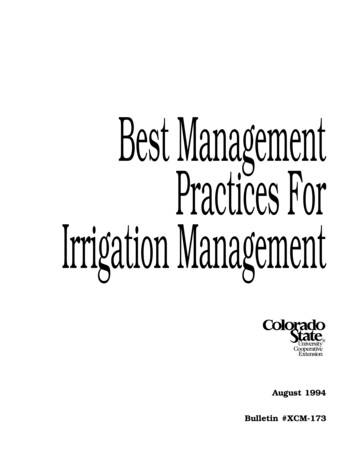
Transcription
Best ManagementPractices ForIrrigation ManagementAugust 1994Bulletin #XCM-173
Principal author:Reagan M. WaskomExtension Water Quality SpecialistColorado State University Cooperative ExtensionIn association with:Colorado Department of Agriculture and theAgricultural Chemicals and Groundwater ProtectionAdvisory CommitteeThe author and the Colorado Department of Agriculture gratefully acknowledge the extensiveinput and leadership of the Agricultural Chemical and Groundwater Protection AdvisoryCommittee, representing production agriculture, agricultural chemical dealers and applicators,the green industry and the general public.With cooperation from:Colorado Department of Health and EnvironmentUSDA Soil Conservation Service – Colorado State OfficeColorado State University Department of Soiland Crop SciencesColorado State University Department of Agand Chemical EngineeringSpecial Acknowledgments toBMP Technical Review Team: G.E. Cardon, Assistant Professor of AgronomyR.L. Croissant, Professor of AgronomyJ.J. Mortvedt, Extension AgronomistG.A. Peterson, Professor of AgronomyL.R. Walker, Extension Agricultural EngineerD.G. Westfall, Professor of AgronomyLayout and Design by:Colorado State University Publications and Creative ServicesGraphics by:Greg Nelson, Colorado State University Officeof Instructional ServicesIssued in furtherance of Cooperative Extension work, Acts of May 8 and June 30, 1914, in cooperationwith the U.S. Department of Agriculture, Milan A. Rewerts, interim director of Cooperative Extension,Colorado State University, Fort Collins, Colorado. Cooperative Extension programs are available to allwithout discrimination. To simplify technical terminology, trade names of products and equipmentoccasionally will be used. No endorsement of products named is intended nor is criticism implied ofproducts not mentioned.Published by Colorado State University Cooperative Extension in cooperation with Colorado Departmentof Agriculture.
Best Management Practicesfor Irrigation PracticesColorado’s 2.5 million acres of irrigated cropproduction are extremely important to the state’s economy.However, poorly managed irrigation may causeenvironmental problems by transporting pesticides,nutrients, and sediments to water supplies. Concern aboutirrigation water is nothing new in Colorado, where irrigationuses about 80% of the 1.8 trillion gallons of water divertedannually in the state. Previously, these concerns centeredonly on water quantity; now, water quality is an importantconsideration in managing irrigation. To reduce nonpointsource pollution caused by leaching and runoff, irrigationsystems should be managed so that the timing and amountof applied water match crop water uptake as closely aspossible.Best Management Practices (BMPs) for the use ofirrigation water can help increase efficiency and uniformityand reduce contamination of water resources. Because eachfarm is unique, producers must evaluate their systems todetermine which BMPs are suitable for their operations.Irrigation management BMPs include irrigation scheduling,equipment modification, land leveling, tailwater recovery,proper tillage and residue management, and chemigationsafety (Figure 1).The BMP ApproachRather than legislate overly restrictive measureson farmers and related industries, the ColoradoLegislature passed the Agricultural Chemicals andGroundwater Protection Act (SB 90-126) to promotethe voluntary adoption of Best Management Practices. The act calls for education and training of allproducers and agricultural chemical applicators inthe proper use of pesticides and fertilizers. Voluntaryadoption of BMPs by agricultural chemical users willhelp prevent contamination of water resources,improve public perception of the industry, andperhaps reduce the need for further regulation andmandatory controls.BMPs are recommended methods, structures, orpractices designed to prevent or reduce water pollution. Implicit within the BMPs concept is a voluntary,site-specific approach to water quality problems. Thisapproach does not require replacements of majorcomponents of an irrigation system. Instead, it issuggested that equipment to manage the timing andamount of water applied be acquired as needed, andthat the appropriate precautions be implementedduring chemigation.Figure 1. Management and site variablesinfluencing pollutant losses fromirrigated fields.Source: US EPA, 1992.1
Irrigation Schedulingare scheduled, whether by sophisticated computercontrolled systems, ditch water availability, or just theirrigator’s hunch as to when water is needed. Experiencedproducers know how long it takes them to get water acrosstheir fields and are proficient in avoiding crop stress duringyears of average rainfall. The difficulty lies in applying onlyenough water to fill the effective root zone withoutunnecessary deep percolation or runoff. Proper accountingfor crop water use provides producers with the knowledgeof how much water should be applied at any one irrigationevent.Proper irrigation scheduling, based on timelymeasurements or estimations of soil moisture content andcrop water needs, is one of the most important BMPs forirrigation management. A number of devices, techniques,and computer aides are available to assist producers indetermining when water is needed and how much isrequired (Table 1).Irrigation scheduling uses a selected watermanagement strategy to prevent the over-application ofwater while maximizing net return. In a sense, all irrigationsTable 1. Irrigation scheduling methods and toolsMethodSoil moisture monitoring(Indicates when and how muchto irrigate)Tools or parameters usedAdvantages/disadvantagesHand feel and appearanceHand probeVariable accuracy, requires experienceSoil moisture tensionTensiometersGood accuracy, easy to read but narrow rangeElectrical resistance testerGypsum blockWorks over large range, limited accuracyIndirect moisture contentNeutron probe/TDRExpensive, many regulationsGravimetric analysisOven and scaleLabor intensiveVisual appearanceField observationVariable accuracyWater stress indexInfrared thermometerExpensiveCheckbook methodComputer/calculatorIndicates when and how much water to applyReference ETWeather station dataRequires appropriate crop coefficientAtmometerWeather station dataRequires appropriate crop coefficientCrop canopy index(Indicates when to irrigate butnot how much to apply)Water budget approach(No field work required, butneeds periodic calibration sinceonly estimates water use)2
The beginning soil water content (θB) is generallyestimated as field capacity if the root zone was fully wettedpreviously. Drainage (Dr) is estimated as the excess waterapplied above the field capacity depth. Precipitation iseasily measured. The main unknown in the balance is ET.This information is generally available for crops in aspecific area through local water districts, the SoilConservation Service, or Cooperative Extension offices.Producers should choose the scheduling methodwhich best suits their needs and management capabilities.Regardless of the method used, some on-site calibration isrequired. Many producers find that irrigation servicesoffered by crop consultants are the most cost-effectivemethod of scheduling and managing their water.Effective scheduling requires knowledge of: soil water-holding capacitycurrent available soil moisture contentcrop water use or evapotranspiration (ET)crop sensitivity to moisture stress at current growth stageirrigation and effective rainfall receivedavailability of water supplylength of time it takes to irrigate a particular field.The decision to irrigate should be based upon anestimate of crop and soil water status, coupled with someindicator of economic return. Proper scheduling may allowproducers to reduce the traditional number of irrigations,thereby conserving water, labor, and plant nutrients. In somecases, the final irrigation of the season can be avoidedthrough proper scheduling. This is especially advantageousfrom a water quality standpoint, because it is desirable to gointo the off-season with a depleted soil profile. This leavesspace for storage of precipitation in the crop root zonewithout unnecessary leaching or runoff.Scheduling irrigation applications is often accomplished by using root zone water balance approaches. Thesemethods use a “checkbook” or budgeting approach toaccount for all inputs and withdrawals of water from thesoil. A simple mathematical expression can be written toillustrate this concept:I P whereI P ET Dr RoθEθBET Dr Ro (θE - θB)irrigation water appliedprecipitationevapotranspiration (soil evaporation plant use)drainage or percolation of water below the rootzone runoff the water content expressed as a depth of water atthe end of a time interval the soil water content (depth) at the beginning ofthe time interval.Figure 2. Source and fate of water in the crop system.3
Soil and Crop PropertiesTable 2. Typical available water-holding capacity of soilsof different textureSoil characteristics which affect irrigationmanagement include the water intake rate, available waterholding capacity, and soil erosivity. Soil texture, organicmatter content, soil structure, and permeability influencethese characteristics and may limit producers’ managementand system options. For this reason, no one type ofirrigation system is universally more efficient than another.Producers should know the predominant soil type ineach field receiving irrigation water. The available waterholding capacity should be used with the current depletionstatus to schedule irrigation (Table 2). This soil informationcan usually be obtained from your local SCS office orcounty soils maps.Crop characteristics influencing irrigationmanagement options include crop water demand andeffective root zone depth (Figure 2). Plants remove waterfrom the soil by a process known as transpiration.Consumptive use refers to the amount of water transpiredby the plant plus what is evaporated from the soil. It isknown as ET and is usually the total amount of watertransferable with a water right (Table 3). ET figures areSoil textural classInches of available waterper foot of soil depthCoarse sandsFine sandsLoamy sandsSandy loamsFine sandy loamsLoamSilty loamsSilty clay loamsSilty clayClay0.60 - 0.800.80 - 1.001.10 - 1.201.25 - 1.401.50 - 2.002.20 - 2.502.00 - 2.501.80 - 2.001.50 - 1.701.30 - 1.50Source: SCS Colorado Irrigation Guide, 1988.usually available locally from weather services, Extensionoffices, or agricultural consultants. Accounting for crop ETbetween irrigations allows producers to determine howmuch water must be replaced in the soil profile.Table 3. Estimated seasonal consumptive water use for selected crops and sitesCropAlfalfaPasture grassDry beansCornVegetablesGrain sorghumPotatoesSugarbeetsWinter wheatSpring wheatBurlingtonDeltaGreeleyMonte VistaRocky Ford- - - - - - - - - - - - - - - - - - - - - - - - inches of water - - - - - - - - - - - - - - - - - - - - - - - 31.029.332.718.016.418.112.714.1Source: SCS Colorado Irrigation Guide, 1988.4
Table 5. Approximate efficiency of various irrigationapplication methodsCrop root depth is primarily influenced by plantgenetics, restrictions within the soil horizon, and thematurity stage of the crop (Table 4). Irrigation water thatpenetrates below crop roots constitutes deep percolation andshould be minimized. Shallow-rooted and young crops withundeveloped root systems present a difficult challengeunder furrow or flood irrigation systems. If shallow-rootedcrops are part of your production system, rotate with deeperrooted crops and manage agricultural chemicals carefully todecrease transport by deep percolation.If the soil at a given site is sandy and depth to thewater table is less than 10 feet, it is recommended thatshallow-rooted crops not be grown under conventionalfurrow irrigation. Deeper rooted crops and higher efficiencyirrigation methods will help minimize groundwater impactsunder these conditions.Conventional furrowSurgeSprinklerDripImproved Irrigation TechnologiesA number of technologies have been developed toapply water more uniformly without excessive waste.Among these are systems such as low-pressure center pivot,LEPA (Low-Energy Precision Application), surge, andmicro-irrigation. These improvements may require capital,energy, or increased management costs, whereas theconventional surface systems often require only minimalmaintenance of delivery systems. However, in some casesthe additional labor savings will justify installation ofimproved systems.Application efficiencies can vary widely amongirrigation methods depending upon soil, crop, topography,climate, and management (Table 5). Irrigation efficiencycan be expressed as the ratio of water needed for cropproduction, to the volume of water diverted for irrigation.Field level irrigation efficiency for a single application canbe calculated as:Table 4. Maximum rooting depths for selected cropsunder furrow irrigationCropCornSmall grainsOnionsSugarbeetAlfalfaDry beansRangeMean- - - - - % efficiency - - - - 25-604030-806060-957580-9590Root depth at maturity (ft)3-53-51-25-85-152-3Ea 5volume of crop evapotranspirationvolume of water applied to field
sharing funds to help install these BMPs. Surface deliverysystems converted from open ditches to gated pipe providea good opportunity to install other BMPs, such as flowmeters or surge valves. If ditches cannot be lined forpractical reasons, metering N fertilizer into irrigation ditchesshould be avoided.Tailwater recovery systems can increase efficiencyand reduce nutrient losses from furrow irrigated fields.Reusing tailwater may require a properly engineered systemthat involves significant costs, maintenance, and landrequirements. Where tailwater reuse is feasible, it providesan excellent means of saving water, energy, and nutrients.Changing from a high pressure center pivot to a lowpressure system ( 35 psi) can reduce pumping costs andincrease efficiency if properly designed. LEPA systemsoperate at even lower pivot pressures and have differentmodes of operation, including chemigation nozzles.Significant trade-offs exist within these systems, such asrunoff potential versus evaporation and drift losses. Theseconsiderations and pump requirements must be evaluatedbefore upgrading a system.Surge flow irrigation uses a valve to send a series ofwater pulses down alternating sets of furrows. Thistechnique requires less total application, reducing runoffwhile increasing uniformity. When properly used, surge cansave labor and water with no loss of crop yield. Irrigatorscurrently using conventional furrow irrigation on coarsetextured soils, fine soils with cracking problems, or slopesin excess of 1% should consider installing surge valves as aBMP.Micro-irrigation systems such as drip or microsprinklers offer the advantage of precise N and irrigationwater management. Fertilizers and some pest controlchemicals can be injected near the end of the irrigation setwith excellent uniformity and little leaching. These systemsare being used profitably in orchards, vineyards, and highvalue row crops. The high initial cost of installation andpotential for clogging with poor quality water presentobstacles for some producers. However, the high uniformity,efficiency, and low labor requirements offer significantadvantages to irrigators short on water.Delivery systems such as lined ditches and gated pipe,as well as reuse systems such as tailwater recovery ponds,can greatly enhance overall efficiency. Seepage fromunlined ditches often results in losses of more than 25% ofdiverted water. When ditch water contains municipaleffluent or added N fertilizer, NO3 leaching from the ditchcan be a problem. Lining ditches with concrete, plastic, orother materials may increase total efficiency and decreasecontaminant loading. Similarly, the installation of pipelineto convey irrigation water can decrease evaporation lossesand seepage. In many cases, the USDA can provide costManaging Surface Irrigated FieldsMost surface irrigation systems have inherentinefficiencies due to deep percolation on the upper end andrunoff at the lower end of the field. Equipment innovationscan reduce these inefficiencies, but management decisionsare very important. Efficient irrigation results when designand management enable producers to uniformly applyenough water to almost fill the effective crop root zone withminimal runoff. The correct amount of water to apply ateach irrigation varies due to changes in root depth, soilmoisture status, and the soil intake rate. The irrigation setsize, stream size, set time, and length of run can beoptimized by irrigators to improve efficiency (Figure 1). Awell designed and properly managed surface system canattain efficiencies of 60% or better.When irrigation is required, it is usually important tocover the entire field as quickly as possible. Irrigatorsshould not be content merely to get the water to the end ofthe furrows, but should also consider how much water isapplied and how it is distributed. Producers should thinkabout surface irrigation in terms of depth of water applied tothe field. The simple relationship AD QT can be used todetermine the amount of water applied by surface irrigationsystems (Figure 3). For example, 1 cubic foot per second(cfs) applied for 2 hours will result in 2 inches of waterapplied to 1 acre.6
Figure 3. Method for determining amount of water applied bysurface irrigation.Information on the leaching and runoff potential ofyour particular site can be obtained from your local SCSoffice. Other agencies such as your water conservancydistrict and Cooperative Extension may be able to provideinformation to help you evaluate groundwater vulnerabilityat your site. A routine water analysis for bacteria and NO3can also help you to determine if your well water is a sourceof concern.Irrigators need a method to measure or accuratelyestimate the amount of water applied to the field. Weirs orflumes can be used to measure water flow in open ditches.Flow meters can be installed in gated pipe systems, orirrigators can simply use a bucket and stop watch toestimate application via siphon tubes. Once application rateis known, producers can determine how much water isactually applied to the field. Balancing the time of set, areaper set, and flow rate to apply the correct amount of water isan essential management practice for all irrigators.Increasing UniformityImproving water distribution uniformity is animportant component of improving irrigation management.Determining distribution requires knowledge of the field,crop, and irrigation system. Producers should probe fieldswithin 72 hours after irrigation to determine depth ofapplication along the irrigation gradient. Checking forvisual signs of plant stress can also indicate areas of poorwater penetration. Most commonly, the upper end of thefield is overwatered and the lower end underwatered (Figure4). Management techniques that can be used to increaseuniformity of application include decreasing row length,field leveling, and installing borders or blocked endfurrows. Unequal water infiltration due to compactionDetermining Leaching HazardThe potential leaching hazard of a given site dependsupon soil properties, management, irrigation method, andclimatic factors. Depth to groundwater and the overlyinggeologic material influence the contamination potential ofan aquifer. Due to the site-specific nature of theseproperties, applicators must determine the relative leachinghazard of each application site in order to select theappropriate BMPs. Operators with sites that have amoderate to severe leaching potential and a shallow watertable ( 25 feet deep) should select the appropriate BMPs todecrease leaching hazard.* 1 cubic foot/second (cfs) 450 gallons/minute 1 acre inch/hour7
caused by equipment traffic can be avoided by in-rowripping at cultivation or sidedressing. Excessive waterintake on coarse soils early in the crop season can bereduced by driving all rows prior to the first irrigation.Surface residues from crop stubble can either increaseor decrease irrigation uniformity depending upon irrigationsystem type and characteristics. Sloping lands with lowintake rate will benefit from increased surface residue.However, furrow irrigated fields with slow advance timesmay be difficult to manage under no-till or reduced tillageoptions. Compliance with USDA mandated conservationprograms may require producers to shorten row lengths andincrease stream size to achieve efficient irrigation underhigh residue farming systems.Length of RunIrrigation runs that are too long result in overwateringat the top of the furrow by the time the lower end isadequately watered (Figure 4). Furrow length should bebased on actual water infiltration rates. The rate waterpenetrates into the soil is a function of soil texture,compaction, and furrow spacing. Infiltration rate will varybetween irrigations and even during a single irrigation.However, after the water has been on the field for one totwo hours, intake rate tends to remain constant and can beused to evaluate irrigation run distance.As a guideline, irrigation runs on leveled fields shouldbe approximately 660 feet on coarse-textured soils or 1,300feet on fine soils. Sloping fields and compacted soils withlower intake rates may allow runs as long as 2,600 feet andstill achieve acceptable uniformity. Improved applicationuniformity, as well as reduced runoff and deep percolation,result from optimizing irrigation run lengths.Land Leveling and Border SystemsLand leveling can improve irrigation uniformitywhenever non-uniform slopes contribute to runoff or deeppercolation. Factors such as soil depth, subsoilcharacteristics, topography, and the economics of landleveling must be considered prior to any leveling, butespecially when deep cuts are necessary. Contact your localSCS office for information on the advisability of levelingspecific fields and for details on cost-share funding.Border systems, blocked end furrows, and level basinspermit water to be applied rapidly and evenly over the setwithout runoff. These systems are best suited to crops thatare not damaged by flooding for short periods of time andon soils where infiltration rates are neither extremely lownor high.Figure 4. Infiltration patterns with furrow irrigation.Source: Eisenhauer et al., 1991.
WaterWaterNPlacementFigure 5. Typical irrigation water movement under alternate furrow N andwater applicationManaging Water Applicationto 0.2 inches per hour. Surface irrigators should experimentwith different combinations of stream size and set times toachieve the greatest uniformity of water infiltration coupledwith the least runoff. When selecting the optimum streamsize, begin with the maximum stream size that does notcause serious erosion. In general, the maximum non-erosivestream size will decrease as slope increases (Table 6). Often,the optimum combination of stream size to set time is theone that advances water to the end of the furrow about halfway through the total set time. However, this may vary withsoil conditions.Irrigating every other furrow supplies water to oneside of each row, resulting in a larger area being coveredduring each irrigation set. This can be especially usefulduring the first irrigation, when it may take considerablylonger for water to get through the field. During dry years,irrigators should switch furrows at each irrigation toimprove nutrient availability. Coupling alternate row Nfertilizer placement with alternate row irrigation may alsoreduce downward movement of NO3 (Figure 5). Anotheradvantage of alternate row irrigation is that the soil profileof a recently irrigated field can store more rainfall withinthe root zone of the unirrigated rows, resulting in lessleaching due to unexpected rainfall. Research has shownthat crop yields compare favorably with fields receivingevery row irrigation. Water savings realized by this methodalso may allow water-short producers to increase overallyields. Alternate row irrigation generally does not work wellon steep slopes or on soils with poor intake rates.Irrigation application rate and set time must beadjusted according to the soil intake rate and slope. Soilsvary significantly in water infiltration rate, ranging from 2.0Table 6. Maximum furrow stream size for various slopesSlopeStream : SCS Colorado Irrigation Guide, 1988.9
Crediting Nitrate in Irrigation WaterLimited IrrigationIrrigation water containing nitrate (NO3) can supply Nto the crop since it is applied and taken up as the crop isactively growing. Water tests for NO3-N should be takenperiodically during the irrigation season to accuratelycalculate this credit. Multiply ppm NO3-N by 2.7 by theamount of effective irrigation water applied (in AF) to thecrop to determine pounds per acre applied in the irrigationwater. Effective irrigation should be calculated based uponactual crop ET. Inexpensive quick tests are available for onfarm water testing. If a water sample is taken for laboratoryanalysis, it should be kept refrigerated, but not frozen, untilit gets to the lab.Limited irrigation may be practiced by water-shortproducers to stretch their water resources and maximizereturns. The water quality benefits of limited irrigationsystems result from the reduced leaching and runoff that thisapproach dictates. Producers limit their use of water in thismethod to only a few well-timed and well-managedapplications. Selection of crops capable of withstandingsome drought stress is critical to tolerating drier thanaverage years under limited irrigation.Salinity ManagementLeaching excess salts which are carried by irrigationwater is necessary in some Colorado soils to avoid saltaccumulation in the root zone. Typically, additional water(known as the leaching requirement) in the amount of about5 to 15% of total consumptive use must be applied annuallyto leach soluble salts from the crop root zone. The leachingrequirement can be calculated fairly precisely as a functionof soil and water salinity. However, most irrigation systemsin Colorado do not achieve efficiencies that warrant theaddition of a leaching fraction.Where leaching for excess salts is necessary becauseof poor quality water, it is essential that the leaching bedone when soil NO3 levels are low and crop N needs havebeen satisfied. Soils should never be intentionally leachedwithin 72 hours after the application of any pesticide.Table 7. N credit from irrigation waterNO3-Nin water(ppm)Effective Irrigation- - - - - - - - - - - - (acre inches) - - - - - - - - - - - 61218243036- - - - - - - - - - - - - - (lb N/A) - - - - - - - - - - - - - 7109129182447729812314510
Managing Sprinkler SystemsOn fine-textured soils, crop yields have not been shown toimprove significantly by this method, but split applicationof N is still a BMP for environmental reasons. Fertilizerapplication through surge flow irrigation systems can beused effectively if tailwater recovery systems are employed.Liquid forms of fertilizer can be added through the systemduring late cutback cycles.Knowledge of the correct amount of fertilizer neededper acre, water application rate, and the acreage under thesurge valve are critical to proper calibration of the fertilizerinjector and length of cycle. A high level of management isneeded to ensure proper cutback cycle settings to avoidrunoff and loss of N to surface waters. Conventional furrowirrigation systems are much more difficult to manage toensure uniformity of application without runoff or leaching.For this reason, application of fertilizer via conventionalsurface irrigation is discouraged, especially in areas withcoarse soils and shallow groundwater. Tailwater recoveryand reuse should be employed on any chemigated field thatproduces significant amounts of runoff.Pesticide application through irrigation water isrestricted by the EPA under current labeling regulations.The EPA requires each chemical label to either specificallyprohibit chemigation or to detail instructions forchemigation on the label. Chemigators should read all labelprecautions, paying close attention to the chemigationinstructions. In Colorado, all chemigators operating closedirrigation systems must have a permit from the ColoradoDepartment of Agriculture and also install backflowprevention valves, inspection ports, or check valves asappropriate. Producers chemigating through open systemswhere backflow cannot occur are not required to obtainpermits to comply with the Colorado Chemigation Act, butstill should observe the appropriate precautions.Sprinkler system operators need to match applicationrates with infiltration rate and the slope of the soil. Highapplication rates can result in surface runoff or in pondingand deep percolation losses. Low application rates can beinefficient due to excessive evaporation. Proper sprinklersystem design is essential to achieve high efficiencies withminimal runoff or deep percolation. Irrigators should adjustapplication depths (speed of travel) to soil moisturedepletion status. Soil moisture monitoring and irrigationscheduling are essential BMPs for managing waterapplication on sprinkler irrigated fields.Basin tillage with a dammer-diker or similarimplement can be used to increase intake and reduce runoffon sloping fields with low infiltration rates under sprinklerirrigation. Basin size and the distance between basins shouldbe adjusted according to slope and soil intake rate. Ingeneral, smaller basins and higher water delivery rates arebest for very permeable soils. Short, wide basins tend to bemore efficient than long, narrow ones.Chemigation SafetyChemigation, the process of appl
Best Management Practices (BMPs) for the use of irrigation water can help increase efficiency and uniformity and reduce contamination of water resources. Because each farm is unique, producers must evaluate their systems to determine which BMPs are suitable for their operations. Irrigation management BMPs include irrigation scheduling,
